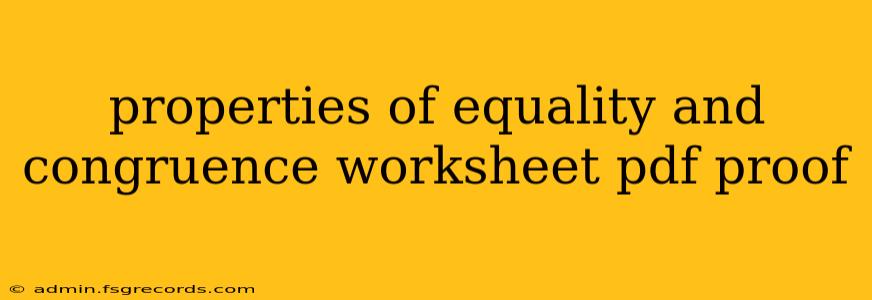This guide provides a detailed explanation of the properties of equality and congruence, crucial concepts in geometry and algebra. We'll explore each property with clear examples and then provide a downloadable worksheet (PDF) to test your understanding. Understanding these properties is fundamental for writing geometric proofs and solving algebraic equations effectively.
Properties of Equality
These properties govern how we manipulate equations while maintaining their truth. They are the backbone of algebraic problem-solving.
1. Reflexive Property of Equality:
- Statement: For any quantity a, a = a.
- Explanation: Something is always equal to itself. This might seem obvious, but it's a foundational property used in proofs.
- Example: 5 = 5; ∠A = ∠A; segment AB = segment AB
2. Symmetric Property of Equality:
- Statement: If a = b, then b = a.
- Explanation: The order of equality doesn't matter. If a equals b, then b also equals a.
- Example: If x = 7, then 7 = x; If ∠P = ∠Q, then ∠Q = ∠P
3. Transitive Property of Equality:
- Statement: If a = b and b = c, then a = c.
- Explanation: If two quantities are equal to the same quantity, then they are equal to each other. This is frequently used in linking different parts of a proof.
- Example: If x = y and y = 5, then x = 5; If AB = CD and CD = EF, then AB = EF
4. Addition Property of Equality:
- Statement: If a = b, then a + c = b + c.
- Explanation: You can add the same quantity to both sides of an equation without changing its truth.
- Example: If x - 3 = 7, then x - 3 + 3 = 7 + 3 (resulting in x = 10)
5. Subtraction Property of Equality:
- Statement: If a = b, then a - c = b - c.
- Explanation: You can subtract the same quantity from both sides of an equation without changing its truth.
- Example: If y + 5 = 12, then y + 5 - 5 = 12 - 5 (resulting in y = 7)
6. Multiplication Property of Equality:
- Statement: If a = b, then ac = bc.
- Explanation: You can multiply both sides of an equation by the same quantity (except zero) without changing its truth.
- Example: If ⅓z = 4, then 3 * (⅓z) = 3 * 4 (resulting in z = 12)
7. Division Property of Equality:
- Statement: If a = b and c ≠ 0, then a/c = b/c.
- Explanation: You can divide both sides of an equation by the same non-zero quantity without changing its truth.
- Example: If 2x = 10, then 2x/2 = 10/2 (resulting in x = 5)
Properties of Congruence
Congruence deals with geometric figures having the same size and shape. These properties mirror those of equality, but apply to geometric objects.
The properties are analogous to those of equality; replace "=" with "≅" (congruent to). For instance:
- Reflexive Property of Congruence: ∠A ≅ ∠A
- Symmetric Property of Congruence: If △ABC ≅ △DEF, then △DEF ≅ △ABC
- Transitive Property of Congruence: If △ABC ≅ △DEF and △DEF ≅ △GHI, then △ABC ≅ △GHI
Worksheet (PDF - Not included as I cannot create a PDF file)
A worksheet containing practice problems applying these properties would be included here. The worksheet would feature a range of exercises, including:
- Identifying the property used: Students would be given equations or geometric statements and asked to identify the property of equality or congruence being applied.
- Solving equations: Students would solve equations using the properties of equality.
- Writing simple geometric proofs: Students would use the properties to justify steps in a proof.
To access a similar worksheet, search online for "properties of equality and congruence worksheet PDF". Many free resources are available.
This guide provides a solid foundation for understanding and applying the properties of equality and congruence. Remember to practice using these properties to build proficiency in both algebra and geometry. Mastering these concepts will greatly enhance your ability to solve problems and write rigorous mathematical proofs.

